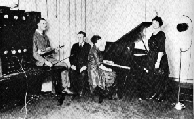

| In the early spring of 1922, the United States Commerce Department
granted the Gimbels Department Store licenses to install and operate radio
stations in Philadelphia and Milwaukee, assigning the call sign WIP to
Philadelphia, but giving one of the first of the new four letter call signs,
WAAK, to the Milwaukee store. Of course, getting a government license for a station was only half the battle, for someone still had to be found to build and install the studio and transmitting equipment. Here in Milwaukee, Gimbels called on one Clarence Bates, who is hereby honored as Milwaukee's first professional broadcast engineer. Bates built a 100-watt transmitter for Gimbels, and erected a 40-foot tower on top of the downtown store. Studio decor of the time demanded heavy drapes and wall coverings, so Bates covered a 17 by 25 foot room on Gimbels third floor with dark maroon velvet to provide the proper acoustic ambience. Nearby stood the wind-up record player for transcription concerts, along with the studio microphone. In those days, the carbon-button microphone was wired directly across the high voltage power supply of the transmitter, so to protect the announcing staff, Clarence suspended the microphone from a handsome brass birdcage stand supplied by the store. Programming for WAAK was supplied by a local musician and producer named Raymond Mitchell, who promptly shanghaied Bates' assistant engineer, Daniel Gellerup (later to become Chief Engineer at WTMJ) to announce the programs. Getting talent for WAAK was simply a matter of scouring the local theaters and recital halls for visiting artists, and securing their (usually willing) cooperation. Mitchell's show business connections were invaluable, since it was thought that listeners took a dim view of the transcription broadcasts, and thus required a steady supply of live voices and music for their listening pleasure. In preparation for the first broadcasts at WAAK, Gimbels established "listening posts" throughout the store, where shoppers were invited to pause and listen to the programs on individual earphones. It is important to remember that the general public was not yet sold on the utility value of a broadcast receiver in the home - the very factor that WAAK was designed to address. Bates continued his fine-tuning and testing of WAAK through the month of April, 1922. On Sunday, April 23, the strains of W.T. Purdy's "On Wisconsin" were heard in a music test. More formal "tests" were heard on the following Monday and Tuesday, when violinist George Lipschultz was presented over WAAK for an audience assembled in the Strand Theatre. One of the local papers remarked that "Every note could be heard with equal distinction." Such tests were actually a means of making sure all the equipment would work for the extended amount of time required to present a full evening of programming. Such testing may also have been a Gimbels company policy, since the other Gimbels station, WIP in Philadelphia, beat a rival department store as "first on the air" by claiming such tests as their first "broadcasting," although their official sign-on was in fact the next day. In any case, the first "official" broadcast over WAAK was presented by Dan Gellerup at 7:30 p.m. Wednesday, April 26, 1922, on the only frequency authorized for domestic broadcasting: 360 meters, or about 830 kHz. And what eventually became of WAAK? The pathfinding Milwaukee station lasted less than a year. In the spring of 1923, new federal regulations mandated the installation of expensive wave-metering equipment at all radio stations. Since by that time there were three other stations on the air in Milwaukee, Gimbels decided to pull the plug on WAAK, thus ending their pioneering experiment in Milwaukee broadcasting. --excerpted from "Once a Century," the annual publication of the Milwaukee Press Club, Volume 89, 1985. Original article by Terry Baun. |
